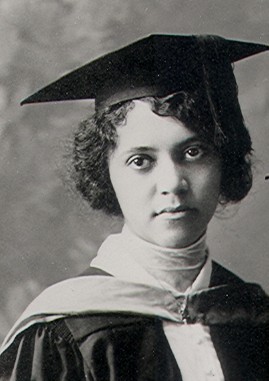Alice Ball
Alice Augusta Ball (July 24, 1892 – December 31, 1916) was an African American chemist who developed the first successful treatment for leprosy during the early 20th century. Her groundbreaking work was largely unrecognized at the time of her death, but she has since been acknowledged for her significant contributions to medicine and chemistry.
Early Life and Education[edit | edit source]
Alice Ball was born in Seattle, Washington, to James P. Ball, Jr., a photographer, and Laura, a schoolteacher. She moved with her family to Honolulu, Hawaii, for health reasons, but they returned to Seattle after a short period. Ball excelled in science and graduated from Seattle High School in 1910. She went on to earn two degrees from the University of Washington; a bachelor's degree in pharmaceutical chemistry in 1912 and a bachelor's degree in the science of pharmacy two years later.
In 1914, Ball became the first African American and the first woman to graduate with a master's degree in chemistry from the College of Hawaii (now the University of Hawaii). Her research at the College of Hawaii involved investigating the chemical properties and active principle of kava for her master's thesis.
Career and Legacy[edit | edit source]
After completing her master's degree, Ball was offered a teaching and research position at the College of Hawaii, making her the first woman to teach chemistry at the institution. During her tenure, she was approached by Dr. Harry T. Hollmann, a physician at Kalihi Hospital in Hawaii, who was seeking a more effective treatment for leprosy (also known as Hansen's disease).
Leprosy was a major health concern in Hawaii at the time, and patients were often forcibly isolated to the Kalaupapa Leprosy Settlement on the island of Molokai. The standard treatment, chaulmoogra oil, had been used for centuries but was largely ineffective due to its difficulty to be absorbed by the body when ingested or injected.
Ball developed a method to isolate the ethyl esters of the fatty acids in the oil, making it possible to inject the treatment directly into the bloodstream, which proved to be an effective treatment for leprosy. Unfortunately, Ball died on December 31, 1916, at the age of 24, before she could publish her findings. After her death, Arthur L. Dean, a chemist and the president of the College of Hawaii, continued her work and began producing large quantities of the extract, often taking credit for Ball's discovery.
It was not until years later that Ball's contributions were fully recognized. In 2000, the University of Hawaii honored her by dedicating a plaque to her on the campus, and in 2007, the university awarded her the Regents' Medal of Distinction. Ball's work has been celebrated in various ways, including the establishment of Alice Ball Day in Hawaii on February 29, 2000.
Death and Recognition[edit | edit source]
Alice Ball died at the young age of 24 under mysterious circumstances, which some sources suggest might have been due to chlorine poisoning during a teaching demonstration. Despite her early death, Ball's legacy lives on through her contributions to science and medicine. She is remembered as a pioneering African American woman in science, breaking barriers in a field that was predominantly male and white at the time.
See Also[edit | edit source]
Search WikiMD
Ad.Tired of being Overweight? Try W8MD's physician weight loss program.
Semaglutide (Ozempic / Wegovy and Tirzepatide (Mounjaro / Zepbound) available.
Advertise on WikiMD
|
WikiMD's Wellness Encyclopedia |
| Let Food Be Thy Medicine Medicine Thy Food - Hippocrates |
Translate this page: - East Asian
中文,
日本,
한국어,
South Asian
हिन्दी,
தமிழ்,
తెలుగు,
Urdu,
ಕನ್ನಡ,
Southeast Asian
Indonesian,
Vietnamese,
Thai,
မြန်မာဘာသာ,
বাংলা
European
español,
Deutsch,
français,
Greek,
português do Brasil,
polski,
română,
русский,
Nederlands,
norsk,
svenska,
suomi,
Italian
Middle Eastern & African
عربى,
Turkish,
Persian,
Hebrew,
Afrikaans,
isiZulu,
Kiswahili,
Other
Bulgarian,
Hungarian,
Czech,
Swedish,
മലയാളം,
मराठी,
ਪੰਜਾਬੀ,
ગુજરાતી,
Portuguese,
Ukrainian
Medical Disclaimer: WikiMD is not a substitute for professional medical advice. The information on WikiMD is provided as an information resource only, may be incorrect, outdated or misleading, and is not to be used or relied on for any diagnostic or treatment purposes. Please consult your health care provider before making any healthcare decisions or for guidance about a specific medical condition. WikiMD expressly disclaims responsibility, and shall have no liability, for any damages, loss, injury, or liability whatsoever suffered as a result of your reliance on the information contained in this site. By visiting this site you agree to the foregoing terms and conditions, which may from time to time be changed or supplemented by WikiMD. If you do not agree to the foregoing terms and conditions, you should not enter or use this site. See full disclaimer.
Credits:Most images are courtesy of Wikimedia commons, and templates Wikipedia, licensed under CC BY SA or similar.
Contributors: Prab R. Tumpati, MD

